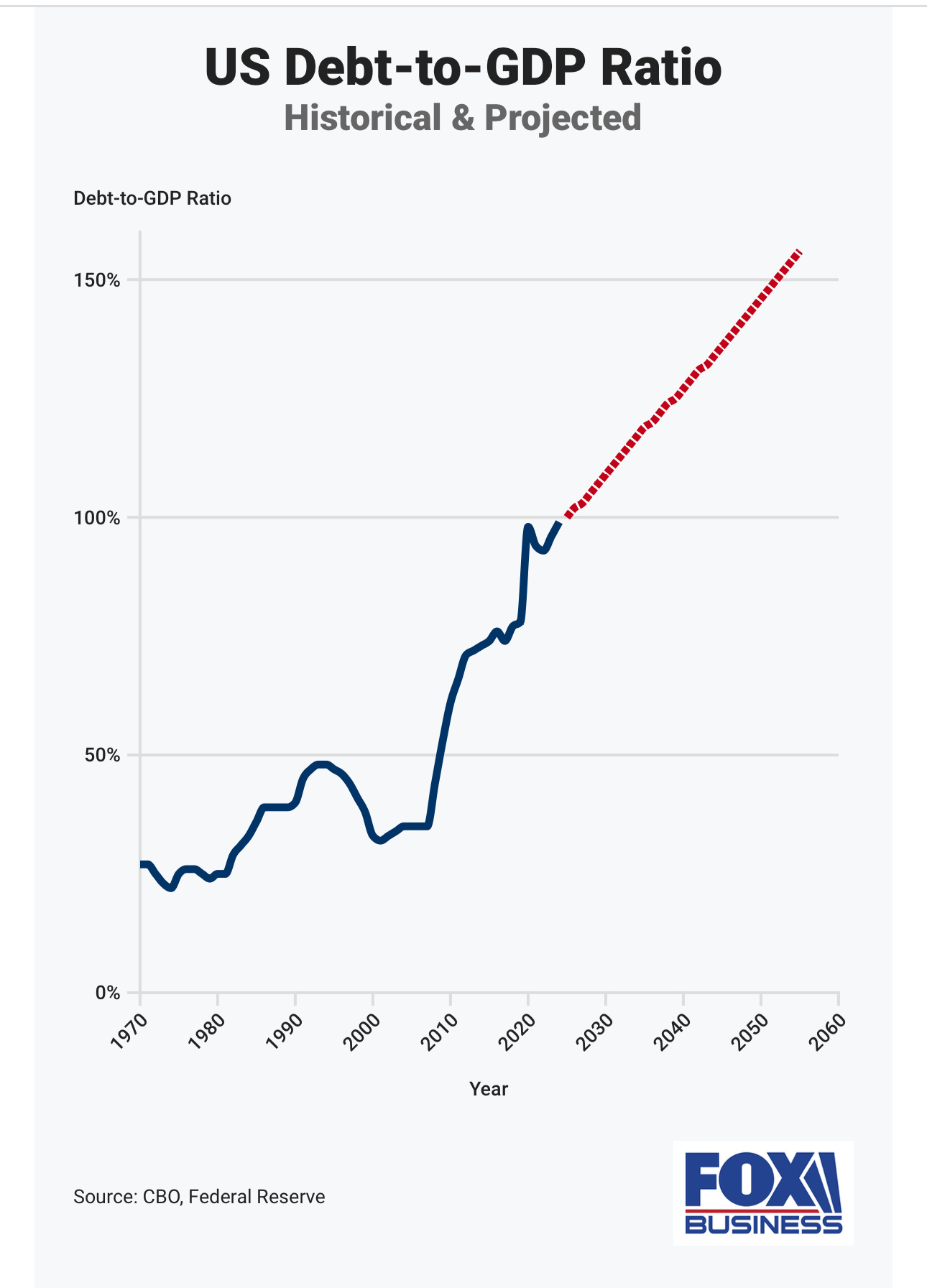
Reasonable Arguments
The national debt and deficit spending during peacetime is a relatively new occurrence.
Both, almost exclusively, started with the selfish baby boom generation. So, it isn’t surprising that the “hands off” protests this past weekend seemed to be over-represented by older people – baby boomers.
The ones who got the U.S. into this mess are the ones protesting the most when a leader tries to get us out of a multi-decade mismanagement of overtaxing, overspending and growing the government.
As a refresher, the baby boomers were born between 1946-1964 (current ages are 61-79 years old) and there are about 71 million baby boomers living in the U.S.
It is during the baby boomers adult years (1970-present) that deficit spending and expanding national debt became the norm, birth rates plummeted along with marriage rates.
About half of adults are unmarried, compared to about 30 percent during the period of 1950-1980. By 2023, more than half of U.S. households were childless and 29 percent of households are those who are married with no children, and about 16.5 percent of people older than 55, have no children. By 2023, 47 percent of adults younger than 50 without children said they aren’t likely to have children which is up from 37 percent in 2018.
It stands to reason that those with children, have a longer, generational view of the future, while those without, are more concerned with the immediate economy and immediate impacts of correcting a generation of misspending.
Now, we’ve seen what I call the “Blue Hair” protests that are commonly called “Hands Off Rallies.”
It appears there are very few people under that age of 50 at this rally, and I bet the majority in this picture are older than 70.
This generation grew up in the violent political rallies of the 1960s which have become the foundation of Democratic political activity, especially when they don’t win elections or, like 2020, want to create social unrest (which is one of 13 factors to determine a presidential election winner) to give democrats a better chance of winning.
From the time I was a child, I heard the rumors that most college protests in the 1960s were organized by students who were likely radicalized by the Soviet Union. It is, at least possible, that the extreme left’s, and certainly the liberal baby boomers, entire political identity is based upon them being manipulated by Communists. I don’t know that I’ll ever be able to prove that claim, but I also don’t know that anyone will ever be able to disprove it, and recent history would suggest that I’m more likely right than wrong.
The lasting legacy of the Baby Boom Generation will be the debt with which they saddled future generations.
Debt-to-GDP:
- 1980: – 33% of GDP
- 2000: – 55% of GDP
- 2025: – 120% of GDP (projected)
- Following the Civil War – 30% of GDP
- Following World War I – 35% of GDP
- The Great Depression – 44% of GDP (after paying down the debt to 20% of GDP)
- Following World War II – 119% of GDP (This is the highest until the 2020s)
- Modern Era (1970-2025) – 35% of GDP in 1970 – 120% of GDP in 2025
- All the data you want on historical debt can be found here.

This graph really takes off during the Obama years, but give Bill Clinton credit for the dip in the 1990s, and Trump for the dip before COVID.
What’s the difference between the different eras of debt accumulation?
In each era listed above, there was a commitment by elected leaders to pay the debt back, until now. This isn’t a partisan criticism, although Biden was likely the greatest overall contributor who added to the debt with no major war or economic downturn to justify his extreme deficit spending.
There is plenty of blame to go around, however, to both republicans and democrats, even Pres. Trump in 2020 due during the Pandemic.
The first three years of Trump’s first term all had deficits of less than $1 trillion with the total debt accumulated during those three years of $2.4 trillion. The Pandemic year of 2020 added another $3.1 trillion in debt.
Biden put deficit spending on steroids. Even if you give Pres. Biden a pass for 2021 when he added $2.7 trillion to the debt; there was no excuse, except to cover a flailing economy due to failed economic and energy policies to continue the rate of deficit spending in his final three years of $1.3 trillion is 2022, $1.7 trillion is 2023, and $1.9 trillion is 2024 adding $5 trillion to the national debt in the three years AFTER the Pandemic was clearly over. Biden’s total addition to the debt was $7.7 trillion.
The U.S. can no longer pretend we are having a great economy through deficit spending. We must balance the budget and start repaying the debt.
I have appeared as a guest on at least a half a dozen international podcasts including podcasts in the U.K, Australia, and New Zealand. In each case, hosts were shocked that the U.S. is $37 trillion in debt and that we are adding $2 trillion in debt per year, every year, with no plans, until now, to slow spending or pay off the debt.
The U.K.’s entire annual budget is less than $1.8 trillion. That’s right, the U.S. is adding more debt per year than it costs the U.K. to fund their entire government.
To say that podcast hosts were shocked would be an understatement. You know why? It is shocking!
It is shocking that foreign countries continue to expect to take advantage of America and Americans by funding their defense, having U.S. companies either pay tariffs to compete in trade in these countries, and by having our grandchildren fund their way of life (The U.S. carries more debt compared to the annual budget than any country in the world).
I was truly offended by Pres. Zelensky in his Fox News interview following the blow up in the oval office last month when he said something like, “I can’t make a deal that puts our grandchildren in debt.” Good for you, but you expect MY grandchildren to go in debt to fund your war? I don’t think so, cowboy.
So, why are baby boomers so opposed to DOGE, tariffs, tax cuts, deregulation and energy independence? That’s presumably what they are protesting when they say, “Hands Off!”
The problem for baby boomers is their hands have been in the cookie jar for their entire lives and now we have a leader who says, “no more.”
Trump’s economic policies are working. Last week’s jobs numbers exceeded expectations by 150 percent. The economy was expected to add 100,000 jobs and the economy added 250,000 jobs, and that is in the headwind of about 100,000 federal workers losing their jobs. Remember that Biden increased the federal workforce by about 30 percent and 900,000 employees in just four years (masquerading his dismal economic policies).
Tariffs are one leg of the four-legged stool. Tax cuts, deregulation and energy independence are the other three (you could add a fifth of reduced government spending and employees).
How’s he doing on the others? These are items implemented just last week:
- About 100,000 federal employees have been laid off.
- The Department of Energy unveiled plans to use thousands of acresof its land — including national laboratory campuses, nuclear sites,and former enrichment plants — to quickly develop data centers thatwill power the artificial intelligence revolution.
- The Department of Energy removed additional regulatory barriers onliquefied natural gas exports.
- The Department of the Interior announced its next oil and gas leasesale in the Gulf of America, fulfilling President Trump’s pledge tounleash American energy.
- The Department of the Treasury withdrew burdensome, duplicativeclimate-based financial risk guidelines from the banking industry.Yes, the markets are down due to tariffs, but more than 50 countries have said they will renegotiate trade deals with the U.S.
- The U.S. House and U.S. Senate seem poised to extend Trump’s 2017 tax cuts.
Not too bad for less than 100 days in office, but the baby boomers want to protest tariffs.
I, personally, think the negative reaction by markets has as much to do with being surprised with the formula being used to determine tariffs and the likely, ongoing confusion about the practical application of that formula to determine the tariff amount for each country (is this determined daily, weekly, quarterly? How often is the trade imbalance used in the formula recalculated? Are these really reciprocal “tariffs” or are they intended to equal trade with all countries?). The formula enacted by the president didn’t match a simple “reciprocal” tariffs policy.
Markets and investors want as much certainty as possible. Reciprocal tariffs seemed like an easy equation. The new equation created a level of uncertainty that was not expected.
As I’ve said before, nothing happens in a vacuum, and neither do tariffs. It does amaze me the number of democrats who support higher prices on consumers by supporting higher corporate taxes who are now against knowing that tariffs could have major, positive impacts on job growth and corporate investments while contributing to potential foreign policy wins.
One thing is for sure, we can’t continue to run the country in the ground the way the baby boomers did. Something, and likely many things, have to change.

Jamie Miller has been a cornerstone of Florida politics since 1998 building a reputation as a seasoned strategist and respected commentator with over two decades of experience in the state’s intricate political arena. His incisive analyses have appeared in nearly every major U.S. newspaper, and he has brought his expertise to live radio, television, and podcasts across the country. Renowned for translating complex political dynamics into clear, compelling insights, Jamie has addressed a wide range of audiences, from intimate policy discussions to large public forums, earning recognition as a trusted voice in the field.
Residing in Sarasota, Jamie co-hosts the “Reasonable Arguments” podcast alongside his wife, Jennifer Bash . Subscribe here to the “Reasonable Arguments” newsletter.

